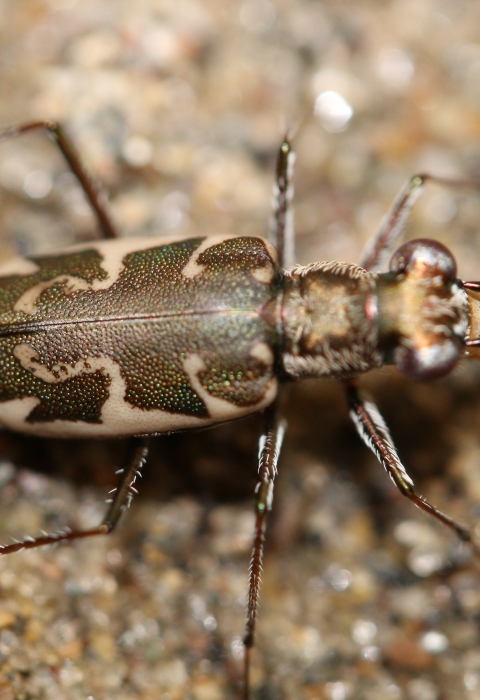Why are Puritan tiger beetles important?
The vast majority of life on earth is made up of plants and invertebrates, like insects. Without these groups, ecosystems would collapse (no plants to eat; no insects to pollinate them). Puritan tiger beetles are a key predator (eats other insects and crustaceans) in its cliff habitat and is, in turn, preyed upon by other insects and birds. And, to the extent that its presence has protected the existence of natural cliffs, it has also protected the habitat of king fishers, bank swallows, and many insect species.
Are Puritan tiger beetles causing the cliffs to erode?
Puritan tiger beetles do not cause cliffs to erode. They occupy eroding cliffs because this is their preferred habitat. Young beetles develop in tiny burrows in sandy soils of the cliff face and adults inhabit the beach below the cliffs.
What is the responsibility of the U.S. Fish and Wildlife Service as the Federal action agency under Section 7 Section 7
Section 7 Consultation
The Endangered Species Act (ESA) directs all Federal agencies to work to conserve endangered and threatened species and to use their authorities to further the purposes of the Act. Section 7 of the Act, called "Interagency Cooperation," is the mechanism by which Federal agencies ensure the actions they take, including those they fund or authorize, do not jeopardize the existence of any listed species.
Learn more about Section 7 a (2) of the Endangered Species Act when someone proposes an action that may adversely affect a federally listed species such as the Puritan tiger beetle?
Each federal agency in consultation with U.S. Fish and Wildlife Service or National Marine Fisheries Service must ensure that any federal action authorized, funded, or carried out is not likely to jeopardize the continued existence of any endangered species or threatened species or result in the destruction or adverse modification of critical habitat of such species.
What is critical habitat?
Critical habitat is a specific geographic area that contains features essential for the conservation of a threatened or endangered species and that may require special management and protection. Critical habitat may also include an area that is not currently occupied by the listed species but that will be needed for its recovery.
Why was no critical habitat designated for the Puritan tiger beetle when it was listed?
Tiger beetles are highly sought after by amateur collectors. Publication of maps detailing specific locations of these beetles would increase the probability of their being overcollected. The designation of critical habitat was determined not to be prudent because the threat of overcollection would outweigh any benefit.
What kind of information must the U.S. Fish and Wildlife Service use to evaluate effects of an action on a threatened or endangered species?
In fulfilling the requirements of the Endangered Species Act, each agency shall use the best scientific and commercial data available. This could include peer reviewed literature, grey literature, unpublished reports, an approved recovery plan, and best professional judgment of species' experts. The Puritan tiger beetle is one of the most studied beetles in North America with index counts dating back to the 1980s.
Do Puritan tiger beetle populations fluctuate?
Puritan tiger beetle populations have large fluctuations from year to year. These variations often appear to be correlated with storms and other weather events. There has been a general decline in overall population size since the 1980s, but because of the large annual fluctuations, there is not a clear linear trend in Puritan tiger beetle numbers. Also, individual populations may show more extreme fluctuations than the metapopulation (a group of spatially separated subpopulations of the same species which interact at some level).
What are the biggest threats to Puritan tiger beetles?
Shoreline development and bluff stabilization are the most serious threats. Shoreline structures may destroy the larval habitat directly or promote vegetation on cliff faces, making the cliffs unsuitable for the Puritan tiger beetle larvae. Some shoreline erosion structures such as segmented offshore or headland breakwaters slow erosion but may allow the maintenance of beach and essential shoreline habitat. Living shorelines also provide erosion control while enhancing the natural shoreline habitat.
Does sea level rise affect the Puritan tiger beetle?
We are uncertain how sea level rise has affected Puritan tiger beetles. Sea level rise may increase the rate of cliff erosion and may also result in narrower beaches. A moderate increase in the rate of cliff erosion is likely to improve the cliff habitat for larval tiger beetles. Further narrowing of beaches is likely to decrease the value of the beach habitat for adult tiger beetles. The net effect on populations of the Puritan tiger beetle is therefore difficult to predict.
Can Puritan tiger beetles exist in other habitats besides high cliffs?
All Maryland populations of the Puritan tiger beetle occur on high cliffs (over 30 feet in height) and on the beaches below and adjacent to them. Larval Puritan tiger beetles develop in borrows in the cliff face and in the breakdown material at the base of the cliff.
Why is maintaining existing habitat for the Puritan tiger beetle so important?
Puritan tiger beetle habitat is limited due to specific requirements needed for the adult and larval life stages. Puritan tiger beetles undergo their entire life cycle on or near cliffs. They require some cliff erosion to maintain unvegetated habitat suitable for larvae. Adult beetles feed and mate on the beach below the cliff. Additionally, this species only occurs in the Chesapeake Bay in Maryland and at a few sites along the Connecticut River in New England. The Chesapeake Bay contains two metapopulations along its shorelines, one on the western shore, and the other on the eastern shore.
Why are the cliffs eroding along the Chesapeake Bay?
Eroding shorelines are a natural feature of the Chesapeake Bay. Geologists indicate that eroding cliffs have been present in the Chesapeake Bay area for thousands of years and that the erosion of these cliffs provides much of the sand supply to the bay beaches there. Eroding shorelines (both eastern and western shorelines) and eroding islands have been well documented and are part of a natural process with a number of contributing factors such as storm events, shoreline soil composition, topography, bathymetry, fetch, surface/groundwater conditions, and manmade impacts such as putting in stabilization measures and surrounding land use.
Why are homes and yards at the tops of the cliff vulnerable?
Erosion at the base of the cliff creates a steep slope. This steepness makes the top of the slope more unstable and saturated soil at the top of the cliff slides off. Exactly when and where these slides occur is hard to predict but it is related to many factors. Soil saturation occurs with natural, prolonged periods of heavy rains and can be compounded by improper drainage from streets, houses, or septic fields.
How can homes and yards at the top of the cliffs be protected?
Many alternatives are being discussed with shoreline erosion control engineers and the communities affected. Protecting the bottom of the slope from erosion can help protect cliffs over time, but may not protect the top of a slope that is already unstable. Rock used to cover the beach may protect the shoreline but destroys the beach and the Puritan tiger beetle habitat. Segmented off-shore breakwaters are another way to reduce erosion and, if designed properly, may not destroy the beach or the tiger beetle habitat. However, it is uncertain if any of these methods will help those homes that are already very close to the edge of unstable slopes. Companies are also trying to develop geotextile material that will control erosion and be beneficial to tiger beetles. So far, the grading of the upper cliff necessary for placement of such material will result in direct mortality of larvae and the placement of the current type of geotextile material will prevent any future use of the cliffs by adult tiger beetles. While it is possible that a geotextile material that tiger beetles would tolerate may be developed, field experimentation would be required to prove that.
How far can Puritan tiger beetles fly to colonize new areas?
Predictions on dispersal of Puritan tiger beetles are based on data available from studies of the related Northeastern beach tiger beetle. These indicate that the Puritan tiger beetles would often migrate 4 miles (6 kilometers) and occasionally as far as 8 miles (13 kilometers). Why can't you just move adult or larval Puritan tiger beetles from a site? Adults can be captured during the summer, but there has been no success introducing them to a new site. Early on this was tried, but the beetles always disappeared. Translocations since then have been conducted with larval beetles, but it is impractical to collect large numbers of larvae from deep burrows located in high cliffs.
Why can't we move Chesapeake Bay beetles to New England?
This is not appropriate because the Chesapeake Bay and New England populations are genetically distinct and use different habitat types. Can you propagate larval beetles to introduce to new sites?
Successful propagation techniques have been developed for the Puritan tiger beetle at the University of Massachusetts. Translocations using propagated larval beetles are only a solution if there are sites with suitable or restorable habitat currently unoccupied by beetles. Numbers of beetles fluctuate due to habitat quality, so adding beetles to sites that are already occupied does not necessarily increase the population size. The U.S. Fish and Wildlife Service, in coordination with the Maryland Department of Natural Resources, is attempting to locate additional potential habitat in the Chesapeake Bay area. There has been limited success in translocating larvae to unoccupied habitats. The largest translocation was attempted with the related Northeastern beach tiger beetle from the Chesapeake Bay to the New Jersey coast. The larvae developed into adults and reproduced, resulting in a fairly large population for 2-3 years; then they nearly disappeared, with the population declining to 7 beetles. In the Chesapeake Bay, larvae raised in the laboratory were placed in rearing tubes and translocated to a cliff face to see if they could successfully mature. However, at the end of the study, none of the translocated larvae could be found including all the rearing tubes. It is not certain why they were lost. Future attempts are still possible.
Can habitat restoration benefit the Puritan tiger beetle?
Habitat restoration may be the key to increasing Puritan tiger beetle populations in Maryland. A restoration study has been conducted at the Sassafras River Natural Resource Management Area on the Eastern Shore. It has been effective in reducing cliff vegetation by the use of herbicide, and Puritan tiger beetle numbers have shown some positive response.




